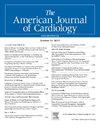成人先天性心脏病与心力衰竭伴射血分数降低的比较研究
IF 2.1
3区 医学
Q2 CARDIAC & CARDIOVASCULAR SYSTEMS
引用次数: 0
摘要
峰值耗氧量(V O2peak)用于预测心力衰竭伴射血分数降低(HFrEF)患者的预后和移植时间;V / o峰值对成人先天性心脏病(ACHD)患者也有预测作用。然而,与HFrEF相比,给定的V o 2峰值对ACHD患者心脏事件的预测价值,特别是在调整了年龄和性别后,尚不清楚。因此,我们进行了一项纵向队列研究,比较了ACHD患者和HFrEF患者。队列性别和年龄匹配(±10岁)。1993 ~ 2012年进行了vo2峰值试验。心脏事件包括死亡、心脏移植和LVAD放置。事件通过电子病历、SSDI和电话访谈获得。Cox比例风险回归分析用于评估无事件生存率与预测变量的关系。ACHD (N = 137)和HFrEF (N = 137)患者的中位随访时间分别为19.0年(14.8 ~ 21.1年)和14.5年(13.4 ~ 15.6年)。在多变量模型中,在ACHD (HR 0.89, 95% CI 0.83 ~ 0.96, p = 0.002)和HFrEF (HR 0.86, 95% CI 0.82 ~ 0.91, p <0.001)中,较高的V / o2峰值与较低的心脏事件风险相关,与年龄和性别无关。男性与心脏事件HFrEF的高风险相关(HR 1.90, 95% CI 1.24 ~ 2.90, p = 0.003),但与ACHD组无关。在多变量调整(β受体阻滞剂、性别和V / o峰值)后,与HFrEF诊断相比,患有ACHD的心脏事件风险降低71% (HR 0.29, 95% CI 0.18 ~ 0.47, p <0.001)。血氧饱和度峰值独立预测成人ACHD或HFrEF患者的无事件生存率,在门诊有临床应用价值。与HFrEF相比,经包括V o 2峰值在内的多变量调整后的ACHD患者预后更好。本文章由计算机程序翻译,如有差异,请以英文原文为准。
Predictive Value of V̇O2peak in Adult Congenital Heart Disease in Comparison With Heart Failure With Reduced Ejection Fraction
Peak oxygen consumption (V̇O2peak) is used to predict outcomes and time to transplantation in patients with heart failure with reduced ejection fraction (HFrEF); V̇O2peak also has predictive utility in patients with adult congenital heart disease (ACHD). However, the predictive value of a given V̇O2peak on cardiac events in patients with ACHD compared to HFrEF, especially after adjustment for age and sex, is unclear. Therefore, we performed a longitudinal cohort study comparing patients with ACHD to patients with HFrEF. The cohorts were sex and age matched (±10 years). V̇O2peak tests were conducted from 1993 to 2012. Cardiac events included death, cardiac transplantation, and LVAD placement. Events were obtained via electronic medical record, SSDI, and phone interview. Cox proportional-hazard regression analyses were used to evaluate relationships of event-free survival with predictor variables. Patients with ACHD (N = 137) and HFrEF (N = 137) had median follow-up times of 19.0 years (14.8 to 21.1) and 14.5 years (13.4 to 15.6), respectively. In multivariable models, Higher V̇O2peak was associated with lower risk for a cardiac event, independent of age and sex, in both ACHD (HR 0.89, 95% CI 0.83 to 0.96, p = 0.002) and HFrEF (HR 0.86, 95% CI 0.82 to 0.91, p <0.001). Male sex was associated with greater risk of a cardiac event HFrEF (HR 1.90, 95% CI 1.24 to 2.90, p = 0.003) but not in ACHD group. After multivariable adjustment (Beta-blockers, sex, and V̇O2peak), having ACHD conferred a 71% lower risk of cardiac events compared to a HFrEF diagnosis (HR 0.29, 95% CI 0.18 to 0.47, p <0.001). V̇O2peak independently predicts event-free survival among adults with ACHD or HFrEF and has clinical utility in outpatient settings. Patients with ACHD have a better prognosis after multivariable adjustment including V̇O2peak compared to HFrEF.
求助全文
通过发布文献求助,成功后即可免费获取论文全文。
去求助
来源期刊

American Journal of Cardiology
医学-心血管系统
CiteScore
4.00
自引率
3.60%
发文量
698
审稿时长
33 days
期刊介绍:
Published 24 times a year, The American Journal of Cardiology® is an independent journal designed for cardiovascular disease specialists and internists with a subspecialty in cardiology throughout the world. AJC is an independent, scientific, peer-reviewed journal of original articles that focus on the practical, clinical approach to the diagnosis and treatment of cardiovascular disease. AJC has one of the fastest acceptance to publication times in Cardiology. Features report on systemic hypertension, methodology, drugs, pacing, arrhythmia, preventive cardiology, congestive heart failure, valvular heart disease, congenital heart disease, and cardiomyopathy. Also included are editorials, readers'' comments, and symposia.
 求助内容:
求助内容: 应助结果提醒方式:
应助结果提醒方式:


